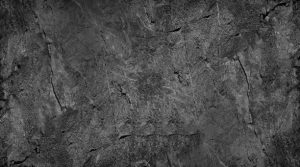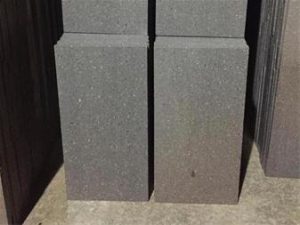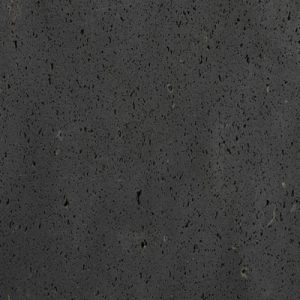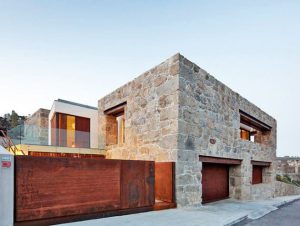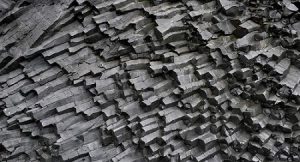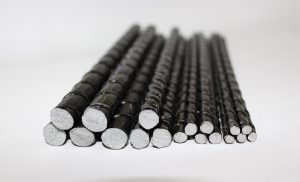Basalt formation process
Basalt stone is one of the volcanic stones that came to the earth’s surface in the form of melt and after cooling rapidly and approximately at a temperature of about 1,200-1,000 degrees Celsius, it turns into solid ice in the form of basalt stone. The formation process of basalt stones is explained as follows:
• Source of melt: Basalt rocks are formed from a source of melt known as magma (volcanic velvety melt). Magmas penetrate from the depths of the earth to the earth’s surface. This melt usually contains minerals such as feldspar, pyroxene, and olivine.
• Water and gases: Magma can also contain various gases such as carbon dioxide (CO2), water (H2O), nitrogen (N2), and other gases. As magma approaches the Earth’s surface, the pressure decreases and gases are released from the magma, which can form as air bubbles in the basalt rock.
• Cooling: When magma reaches the Earth’s surface, the temperature drops drastically. This causes it to form solid ice when exposed to air at approximately 1,200-1,000 degrees Celsius. Basalt stone is formed through a process called solidification.
• Crystalline structure: Basalt rock has a crystalline structure and usually includes microcrystalline grains of feldspar (such as andesite or plagioclase) and pyroxene (such as augite). These microcrystalline grains are frequently seen in alternating layers in basalt.
• External characteristics: Basalt stone is usually dark in color and has a rough and rough surface. As a volcanic rock, it can be found in volcanic areas.
The formation process of this rock is one of the important steps in the volcanic cycle and the formation of volcanic rocks.
Advantages of using basalt stone
Basalt is used in various fields for various reasons and its advantages are as follows:
• High physical resistance:
Basalt stones have a resistant and hard mechanical structure, which makes it suitable for construction and road construction purposes. This resistance allows basalt stone to withstand heavy loads and pressure shocks.
• Erosion resistance:
Basalt is resistant to chemical and mechanical erosion and therefore can remain under the influence of environmental factors for a long time in different environmental conditions.
• Beautiful appearance:
Basalt stone has a beautiful appearance with dark color and rough surface, which is commonly used in landscape design and decoration projects.
• Heat resistance:
Part of the magmas that have turned into basalt rocks are formed by high temperature and volcanic activity. Therefore, these stones have heat resistance and can be used in projects that require heat resistance.
Road construction costs:
Due to the resistance and hardness of basalt stone, it is used as a road construction material in road construction projects and the construction of roads and boulevards.
• Geological stability:
Basalt stone is suitable for transportation and containment stabilization projects such as retaining walls and scales due to its weight and resistance to pressure.
• Volcanic uses:
Basalt stones are used as construction and infrastructure materials in volcanic areas. These stones are usually produced through mining from volcanic areas.
Artistic uses: basalt stones are also used in artistic and architectural artifacts and attract attention as an architectural and aesthetic material.
In general, due to its physical and mechanical characteristics, this stone is suitable for various uses in various industries and is considered as a rich source of useful minerals. Enter the link to learn about gray basalt stone.
How to use basalt stones
Basalt stone is used as a construction or infrastructure material in various projects and applications. Below are some of the common ways of using basalt stone: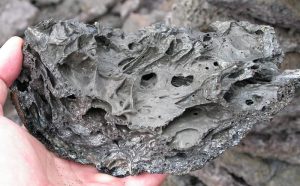
• Road construction: This stone is widely used as a road construction material. It is used to build roads, boulevards, bridges, transportation, and other structures in urban and rural environments.
• Construction and renovation of buildings: This stone is used as a building material in the construction and renovation of buildings. It is used to make walls, stairs, floors, trenches, and interior and exterior decorations of buildings.
• Sidewalks and Access Paths: This stone is used as a material for the construction of sidewalks, access paths, and public spaces in parks and urban environments.
• Weathering materials: Due to its resistance to erosion, basalt stone is used to make weathering materials such as lake shores and sea shores.
• Stabilization materials: basalt stones are used in transportation stabilization projects such as retaining walls, scales, and similar structures for flood control and sedimentation.
• Volcanic materials: In volcanic regions, basalt stone is usually used as construction and infrastructure materials. These stones are suitable in these areas due to their resistance to heat and high pressure.
Art and decorations: Basalt stones are also used as a beautiful material in art and architecture. It is used to make sculptures, exhibits, statues, and architectural decorations.
• Meteorology: Basalt stones are used to make meteorological equipment and equipment related to weather research due to its resistance to harsh environmental conditions.
Note that the use of this basalt stone should be done and optimized according to the needs and specifications of your specific project. Also, in each region and country, the standards and regulations related to the use of basalt stone may be different, so it is important to familiarize yourself with the local and national regulations and use authentic and quality materials.
The difference between andesite and basalt
Andesite and basalt are two types of volcanic rocks that are formed in volcanic melts. These two stones have important differences in mineral composition, color, yield and geological features. Here are the main differences between andesite and basalt:

Mineral composition:
• Andesite: Andesite has a dominant mineral composition of feldspar (usually plagioclase) and pyroxene (such as augite or augite). This rock may also contain small amounts of other minerals.
• Basalt: Basalt has a dominant mineral composition of feldspar (usually andesine) and pyroxene (such as augite or olivine). This rock may also contain small amounts of other minerals.
Color:
• Andesite: Andesite is usually green to gray in color.
• Basalt: Basalt is known as a darker rock and is usually black to gray in color.
Achieved:
• Andesite: Andesite has a rough and rough finish.
• Basalt: Basalt also has a rough texture, but may be a little softer than andesite.
Geological features:
• Andesite: Andesite is usually found in younger tectonic zones and is known as a continental volcanic rock.
• Basalt: Basalt is found in older tectonic zones and in most marine and oceanic tectonic zones. It is known as oceanic volcanic rock.
Other features:
Andesite: This rock may contain small amounts of crystals and minerals collected in the magma.
Basalt: Basalt has commonly seen eye-like minerals known as eye-like plagioclase.

